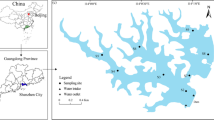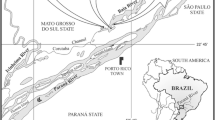Abstract
In this study, the structure of phytoplankton communities in reservoirs with constant cyanobacteria blooms was evaluated using stability, persistence and species richness analyses. Samples were collected monthly from three reservoirs in northeastern Brazil between February 2012 and January 2013. The phytoplankton taxa were quantified under an inverted microscope. Stability was measured using Spearman’s coefficient, based on the analysis of abundance rankings; persistence was measured using the inverse calculation for turnover; and richness was calculated using the number of species. Statistical analyses were used to determine the influence of abiotic variables on persistence and stability, and correlations were performed between persistence and stability and between species richness and stability. Cyanobacteria, particularly Cylindrospermopsis raciborskii (Woloszynska) Seenayya et Subba Raju, were observed in all samples. The results showed that stability and persistence were high, whereas species richness was low in the reservoir communities. The nutrients nitrate, nitrite and orthophosphate influenced persistence, whereas pH and ammonium explained stability. Persistence and stability were not significantly correlated, but a negative correlation was observed between species richness and stability.



Similar content being viewed by others
References
Ayres M, Ayres Junior M, Ayres DL, Dos Santos AS (2007) Manual BioEstat 5.0. Imprensa Oficial do Estado do Pará, Belém
Bittencourt-Oliveira MC, Piccin-Santos V, Moura AN, Aragão-Tavares NKC, Cordeiro-Araújo MK (2014) Cyanobacteria, microcystins and cylindrospermopsin in public drinking supply reservoirs of Brazil. An Acad Bras Cienc 86:297–310. doi:10.1590/0001-3765201302512
Bonilla S, Aubriot L, Soares MCS, González-Piana M, Fabre A, Huszar VM, Lürling M, Antoniades D, Padisák J, Kruk C (2012) What drives the distribution of the bloom-forming cyanobacteria Planktothrix agardhii and Cylindrospermopsis raciborskii? FEMS Microbiol Ecol 79:594–607. doi:10.1111/j.1574-6941.2011.01242.x
Bonilla S, González-Piana M, Soares MCS, Huszar VLM, Becker V, Somma A, Marinho MM, Kokociński M, Dokulil M, Antoniades D, Aubriot L (2016) The success of the cyanobacterium Cylindrospermopsis raciborskii in freshwaters is enhanced by the combined effects of light intensity and temperature. J Limnol 75:606–617
Bouvy MA, Falcão D, Marinho M, Pagano M, Moura A (2000) Occurrence of Cylindrospermopsis (Cyanobacteria) in 39 brazilian tropical reservoirs during the 1998 drought. Aquat Microb Ecol 23:13–27
Bouvy M, Nascimento SM, Molica RJR, Ferreira A (2003) Limnological features in Tapacurá reservoir (northeast Brazil) during a severe drought. Hydrobiologia 493:115–130. doi:10.1023/A:1025405817350
Brookes JD, Carey CC (2011) Resilience to blooms. Science 334:46–47. doi:10.1126/science.1207349
Chalar G (2009) The use of phytoplankton patterns of diversity for algal bloom management. Limnologica 39:200–208. doi:10.1016/j.limno.2008.04.001
Clarke K (1993) Non-parametric multivariate analyses of changes in community structure. Aust J Ecol 18:117–143
Connell JH, Sous WP (1983) On the evidence needed to judge ecological stability or persistence. Am Nat 21:789–824. doi:10.1086/284105
Corcoran AA, Boeing WJ (2012) Biodiversity increases the productivity and stability of phytoplankton communities. PLoS ONE 7:e49397
Cottingham KL, Brown BL, Lennon JT (2001) Biodiversity may regulate the temporal variability of ecological systems. Ecol Lett 4:72–85. doi:10.1046/j.1461-0248.2001.00189.x
Diamond JM, May RM (1977) Species turnover rates on islands: dependence on census interval. Science 197:266–270. doi:10.1126/science.197.4300.266
Esteves FA (2011) Fundamentos de Limnologia, 3rd edn. Interciência, Rio de Janeiro
Figueredo CC, Giani A (2009) Phytoplankton community in the tropical lake of Lagoa Santa (Brazil): conditions favoring a persistent bloom of Cylindrospermopsis raciborskii. Limnologica 39:264–272. doi:10.1016/j.limno.2009.06.009
Filstrup CT, Hillebrand H, Heathcote AJ, Harpole WS, Downing JA (2014) Cyanobacteria dominance influences resource use efficiency and community turnover in phytoplankton and zooplankton communities. Ecol Lett 17:464–474
Flöder S, Hillebrand H (2012) Species traits and species diversity affect community stability in a multiple stressor framework. Aquat Biol 17:197–209
Gemelgo MCP, Mucci JLN, Navas-Pereira D (2009) Population dynamics: seasonal variation of phytoplankton functional groups in Brazilian reservoirs (Billings and Guarapiranga, São Paulo). Braz J Biol 69:1001–1013
Holzmann R (1993) Seasonal fluctuations in the diversity and compositional stability of phytoplankton communities in small lakes in upper Bavaria. Hydrobiologia 249:101–109. doi:10.1007/BF00008846
Jochimsen MC, Kümmerlin R, Straile D (2013) Compensatory dynamics and the stability of phytoplankton biomass during four decades of eutrophication and oligotrophication. Ecol Lett 16:81–89. doi:10.1111/ele.12018
Jöhnk KD, Huisman J, Sharples J, Sommeijer B, Visser PM, Stroom JM (2008) Summer heatwaves promote blooms of harmful cyanobacteria. Glob Change Biol 14:495–512
Kokociński M, Stefaniak K, Mankiewicz-Boczek J, Izydorczyk K, Soininen J (2010) The ecology of the invasive cyanobacterium Cylindrospermopsis raciborskii (Nostocales, Cyanophyta) in two hypereutrophic lakes dominated by Planktothrix agardhii (Oscillatoriales, Cyanophyta). Eur J Phycol 45:365–374. doi:10.1080/09670262.2010.492916
Komárek J, Anagnostidis K (2005) Cyanoprokaryota 2. In: Büdel B, Krienitz L, Gärtner G, Schargerl M (eds) Teil: Oscillatoriales. Süßwasserflora von Mitteleuropa. Band. 19/2. Elsevier GmbH, München
Komárek J, Zapomělová E (2007) Planktic morphospecies of the cyanobacterial genus Anabaena = subg. Dolichospermum—1. part: coiled types. Fottea 7:1–31
Korhonen JJ, Wang J, Soininen J (2011) Productivity-diversity relationships in lake plankton communities. PLoS ONE 6:1–11. doi:10.1371/journal.pone.0022041
Koroleff F (1976) Determination of nutrients. In: Grasshoff K (ed) Methods of seawater analysis. Verlag Chemic Weinheim, New York, pp 117–181
Krammer K, Lange-Bertalot H (1991a) Bacillariophyceae, 3. Teil: Centrales, Fragilariaceae, Eunotiaceae. In: Ettl H, Gärtner G, Heynig H, Mollenhauer D (eds) Süßwasserflora von Mitteleuropa 2/3. Gustav Fischer, Lübeck
Krammer K, Lange-Bertalot H (1991b) Bacillariophyceae, 4. Teil: Achananthaceae, Kritische Ergänzungen zu Navicula (Lineolatae) and Gomphonema. In: Ettl H, Gärtner G, Heynig H, Mollenhauer D (eds) Süßwasserflora von Mitteleuropa 2/4. Gustav Fischer Verlag, Stuttgart
Lobo E, Leighton G (1986) Estructuras comunitarias de lãs fitocenosis planctônicas de los sistemas de desembocaduras de rios y esteros de la zona central de Chile. Rev Biol Mar Oceanog 22:1–29
López-Archilla AI, Moreira D, López-García P, Guerrero C (2004) Phytoplankton diversity and cyanobacterial dominance in a hypereutrophic shallow lake with biologically produced alkaline pH. Extremophiles 8:109–115. doi:10.1007/s00792-003-0369-9
Lund JWG, Kipling C, Le Cren ED (1958) The invert microscope method of estimating algal numbers and the statistical basis of estimations by counting. Hydrobiologia 11:143–170. doi:10.1007/BF00007865
Mackereth FJH, Heron J, Talling JF (1978) Water analysis: some revised methods for limnologists. Freshwater Biological Association Scientific Publication 36. pp 120
Mateucci SD, Colma A (1982) Metodologia para el estudio de la vegetación. Collecion de monografías científicas, (Série Biologia). Secretaria General de la Organizacion de los Estados Americanos, Washington
Matthews B, Pomati F (2012) Reversal in the relationship between species richness and turnover in a phytoplankton community. Ecology 93:2435–2447. doi:10.2307/41739314
May RM (1973) Stability and complexity in model ecosystems. Princeton University Press, New Jersey
Mc Naughton SJ (1977) Diversity and stability of ecological communities: a comment on the role of empiricism in ecology. Am Nat 111:515–525. doi:10.1086/283181
Meffe GK, Minckley WL (1987) Persistence and stability of fish and invertebrate assemblages in a repeatedly disturbed Sonoran desert stream. Am Midl Nat 117:177–191. doi:10.2307/2425718
Mehnert G, Leunert F, Cires S, Johnk KD, Rucker J, Nixdorf B, Wiedner C (2010) Competitiveness of invasive and native cyanobacteria from temperate freshwaters under various light and temperature conditions. J Plankton Res 32:1009–1021. doi:10.1128/AEM.68.9.4486-4494.2002
Moura AN, Araújo MKC, Soriano HBO, Lira GAST, Nascimento EC (2010) Cianobactérias planctônicas em reservatório eutrófico do estado de Pernambuco. In: Moura NA, Araújo EL, Bittencourt-Oliveira MC, Pimentel RMMP, Albuquerque UP (eds) Reservatórios do Nordeste do Brasil: Biodiversidade, ecologia e manejo. 1st ed, Nuppea, pp 115–143
O’Neil JM, Davis TW, Burford MA, Gobler CJ (2012) The rise of harmful cyanobacteria blooms: the potential roles of eutrophication and climate change. Harmful Algae 14:313–334
Padisák J, Reynolds CS (1998) Selection of phytoplankton associations in Lake Balaton, Hungary, in response to eutrophication and restoration measures, with special reference to cyanoprokaryotes. Hydrobiologia 384:41–53. doi:10.1023/A:1003255529403
Paerl HW, Huisman J (2008) Blooms like it hot. Science 320:57–58
Parparov A, Gal G, Zohary T (2015) Quantifying the ecological stability of a phytoplankton community: the Lake Kinneret case study. Ecol Indic 56:134–144
Popovský J, Pfiester LA (1990) Dinophyceae (Dinoflagellida). In: Ettl H, Gärtner G, Heynig H, Mollenhauer D (eds) Süßwasserflora von Mitteleuropa 6. Gustav Fischer Verlag, Stuttgart
Reynolds CS (1993) Scales of disturbance and their role in plankton ecology. Hydrobiologia 249:157–171
Reynolds CS (2006) The ecology of phytoplankton (ecology, biodiversity, and conservation). Cambridge University Press, Cambridge
Ruan S (1995) The effect of delays on stability and persistence in plankton models. Nonlinear Anal Theory Methods Appl 24:575–585. doi:10.1016/0362-546X(95)93092-I
Scarsbrook M (2002) Persistence and stability of lotic invertebrate communities in New Zealand. Freshwater Biol 47:417–431. doi:10.1046/j.1365-2427
Schabhüttl S, Hingsamer P, Weigelhofer G, Hein T, Weigert A, Striebel M (2013) Temperature and species richness effects in phytoplankton communities. Oecologia 171:527–536
Schneck F, Schwarzbold A, Rodrigues SC, Melo AS (2011) Environmental variability drives phytoplankton assemblage persistence in a subtropical reservoir. Aust Ecol 36:839–848. doi:10.1111/j.1442-9993.2010.02224.x
Simpson C, Kiessling W (2010) The role of extinction in large-scale diversity-stability relationships. P Biol Sci 277:1451–1456. doi:10.1098/rspb.2009.2062
Soares MCS, Huszar VL, Miranda MN, Mello MM, Roland F, Lürling M (2013) Cyanobacterial dominance in Brazil: distribution and environmental preferences. Hydrobiologia 717:1–12
Soininen J, Eloranta P (2004) Seasonal persistence and stability of diatom communities in rivers: Are there habitat specific differences? Eur J Phycol 39:153–160. doi:10.1080/0967026042000201858
Soininen J, Tallberg P, Horppila J (2005) Phytoplankton community assembly in a large boreal lake—deterministic pathways or chaotic fluctuations? Freshwater Biol 50:2076–2086. doi:10.1111/j.1365-2427.2005.01459.x
SRHPE- Secretaria de Recursos Hídricos de Pernambuco (2014) http://www.sirh.srh.pe.gov.br/site/index.php?option=com_contentandview=articleandid=327:barragens-de-contencao-de-cheias
Strickland JD, Parsons TR (1965) A manual of sea water analysis. Bulletin 25:1–185
Sun J, Liu D (2003) Geometric models for calculating cell biovolume and surface area for phytoplankton. J Plankton Res 25:1331–1346. doi:10.1093/plankt/fbg096
Tian W, Zhang H, Zhao L, Xu X, Huang H (2016) Plankton community stability and its relationship with phytoplankton species richness in Lake Nansihu, China. Water 8:454. doi:10.3390/w8100454
Tilman D, Downing JA (1994) Biodiversity and stability in grasslands. Nature 367:363–365. doi:10.1038/367363a0
Utermöhl H (1958) Zur Vervollkommnung der quantitativen Phytoplankton Methodik. Mitteilung Internationale Vereinigung fuer Theoretische unde Amgewandte Limnologie 9:1–38
Vieira LCG, Marques GS, Bini LM (2005) Estabilidade e persistência de assembléias zooplanctônicas em um pequeno lago tropical. Acta Sci Biol Sci 27:323–328. doi:10.4025/actascibiolsci.v27i4.1267
Wetzel RG, Likens GE (2000) Limnological analyses, 3rd edn. Springer, New York
Whitton BA, Potts M (eds) (2000) The ecology of cyanobacteria: their diversity in time and space. Kluwer, Dordrecht
Worm B, Barbier EB, Beaumont N, Duffy JE, Folke C, Halpern S, Jackson JBC, Lotze HK, Micheli F, Palumbi SR, Sala E, Selkoe KA, Stachowicz JJ, Watson R (2006) Impacts of biodiversity loss on ocean ecosystem services. Science 314:787–790
Acknowledgements
The authors wish to express their thanks to Coordenação de Aperfeiçoamento de Pessoal de Nível Superior (CAPES) and Conselho Nacional de Desenvolvimento Científico e Tecnológico (CNPq) for the financial support (Proc. 301715/2008-4, 302068/2011-2 and 471603/2012-0) to carry out this study.
Author information
Authors and Affiliations
Corresponding author
Rights and permissions
About this article
Cite this article
Aragão-Tavares, N.K.C., Moura, A.N. & Dantas, Ê.W. Persistence and stability of phytoplankton communities in eutrophic reservoirs of northeastern Brazil. Braz. J. Bot 40, 749–759 (2017). https://doi.org/10.1007/s40415-017-0387-y
Received:
Revised:
Accepted:
Published:
Issue Date:
DOI: https://doi.org/10.1007/s40415-017-0387-y




